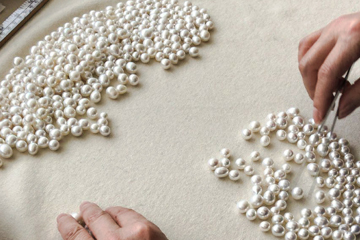Pearl Grading

Beauty is the most important criteria when selecting a pearl. Every pearl at Devino is graded using the 5 key characteristics: lustre, surface quality, shape, colour, and size.
Lustre
This refers to the shine or brilliance of the pearl. High lustre is an indication of a healthy coating and is thus an assurance of durability. Very high lustre pearls have sharp, intense, and almost mirror-like reflections. Very low lustre pearls look milky or chalky. There cannot be a good lustre on a thinly coated pearl.
- Excellent = very sharp reflections: bright, shiny, lively, and clear (mirror like)
- Good = bright reflections but not so sharp
- Fair = weaker reflections, not so clear

Surface Quality
Very few pearls have a perfectly flawless complexion. A higher-grade pearl will have a clean surface with minimal imperfections. These are natural characteristics and do not forcibly diminish the overall beauty of the pearl. As good quality pearls spend at least two years in an oyster (one year for Akoya), it is rare to find a pearl completely devoid of any surface inclusions.
- Flawless = a clean pearl or with only 1 or 2 minor imperfections that is not visible to the trained eye
- Very Slight Inclusions = a few minor imperfections visible to the trained eye on no more than 30% of the pearl and generally a clean look
- Slight Inclusions = noticeable surface irregularities on a larger surface area of the pearl
- Inclusions = strong surface imperfections that affect the look of the whole pearl

Shape
Pearls come in various shapes, including round, oval, button, drop, and baroque. Market demand for certain shapes will affect the price of pearls however any shape can be of excellent quality, and it is a personal preference.

Colour
Pearls come in a range of colours, including white, cream, pink, silver, and black. Unusual or rare colours may increase the value of the pearl however it is mostly a personal choice and does not affect the pearl’s quality.

Size
The size of the pearl is also an important factor in grading. Larger pearls are generally more valuable, with size being measured in millimetres.

Follow us: